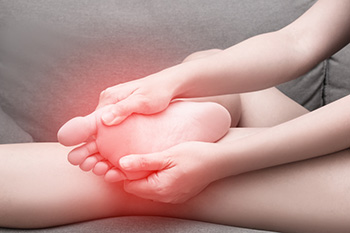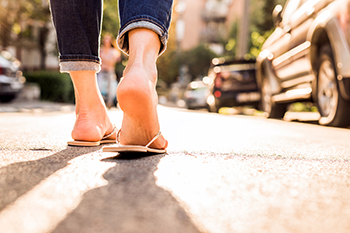Freehold (732) 294-9393
Freehold (732) 294-9393

The metatarsals are long bones in the foot that link the toes with the heel and arch. When these metatarsal bones are repeatedly stressed over time (as opposed to a sudden or acute injury), a stress fracture can occur. The second and third metatarsals are the most commonly injured, and can occur more frequently in military recruits, athletes and dancers who run and jump regularly. Metatarsal stress fractures can be caused by overtraining, long-distance running, having poor body mechanics or running form, pushing your body beyond your fitness level, or training with improper footwear or on hard surfaces. Having diabetes or certain forms of arthritis can also increase your risk factors, as can vitamin D or calcium deficiencies. Signs of a metatarsal fracture include pain in the metatarsal(s), as well as tenderness, or swelling in the area. If you have symptoms like these, it is suggested that you stop participating in physical activity until you can be examined and evaluated by a podiatrist. If you do have a metatarsal fracture, your podiatrist may treat it with rest, stretching and/or muscle strengthening exercises, icing, immobilization, casting, prescription footwear, and more.
Stress fractures occur when there is a tiny crack within a bone. To learn more, contact Dr. Henry Miller from New Jersey. Our doctor can provide the care you need to keep you pain free and on your feet.
How Are They Caused?
Stress fractures are the result of repetitive force being placed on the bone. Since the lower leg and feet often carry most of the body’s weight, stress fractures are likely to occur in these areas. If you rush into a new exercise, you are more likely to develop a stress fracture since you are starting too much, too soon. Pain resulting from stress fractures may go unnoticed at first, however it may start to worsen over time.
Risk Factors
Stress fractures do not always heal properly, so it is important that you seek help from a podiatrist if you suspect you may have one. Ignoring your stress fracture may cause it to worsen, and you may develop chronic pain as well as additional fractures.
If you have any questions, please feel free to contact our office located in Freehold, NJ . We offer the newest diagnostic and treatment technologies for all your foot care needs.
 The idea of wearing flip flops is appealing to many people. They are easy to wear and are available in a variety of styles and colors. However, research has indicated that this style of shoe may cause damage to the feet. A person's gait or walking pattern could be negatively impacted in order to accommodate for the lack of arch support and cushioning, and the ankles may turn inward. It can also be easier to stub your toe while wearing flip flops, which may result in a broken toe. Additionally, the toes are constantly gripping the front of the shoe to keep it securely on the foot. This repeated action may cause strain in the overall foot, or cramps may develop as well. There are several other foot conditions that can result from wearing flip flops as well. If you are interested in learning more about the effects flip flops can have on the feet, please speak with a podiatrist.
The idea of wearing flip flops is appealing to many people. They are easy to wear and are available in a variety of styles and colors. However, research has indicated that this style of shoe may cause damage to the feet. A person's gait or walking pattern could be negatively impacted in order to accommodate for the lack of arch support and cushioning, and the ankles may turn inward. It can also be easier to stub your toe while wearing flip flops, which may result in a broken toe. Additionally, the toes are constantly gripping the front of the shoe to keep it securely on the foot. This repeated action may cause strain in the overall foot, or cramps may develop as well. There are several other foot conditions that can result from wearing flip flops as well. If you are interested in learning more about the effects flip flops can have on the feet, please speak with a podiatrist.
Flip-flops can cause a lot of problems for your feet. If you have any concerns about your feet or ankles, contact Dr. Henry Miller from New Jersey. Our doctor will assist you with all of your foot and ankle needs.
Flip-Flops and Feet
Flip-flops have managed to become a summer essential for a lot of people. While the shoes may be stylish and easy to slip on and off, they can be dangerous to those who wear them too often. These shoes might protect you from fungal infections such as athlete’s foot, but they can also give you foot pain and sprained ankles if you trip while wearing them.
When Are They Okay to Wear?
Flip-flops should only be worn for very short periods of time. They can help protect your feet in places that are crawling with fungi, such as gym locker rooms. Athlete’s foot and plantar warts are two common fungi that flip-flops may help protect your feet against.
Why Are They Bad for My Feet?
These shoes do not offer any arch support, so they are not ideal for everyday use. They also do not provide shock absorption or heel cushioning which can be problematic for your feet. Additionally, you may suffer from glass cuts, puncture wounds, and stubbed toes since they offer little protection for your feet.
More Reasons Why They Are Bad for Your Feet
If you have any questions, please feel free to contact our office located in Freehold, NJ . We offer the newest diagnostic and treatment technologies for all your foot care needs.
Diabetes may increase your risk of peripheral arterial disease (PAD), which is a narrowing of the arteries due to prolonged elevated blood glucose levels. PAD may lead to poor circulation. Symptoms of PAD in your lower extremities may include brittle toenails, cold or numb feet, a loss of hair on the feet or legs, a bluish tinge to the skin on the legs, cracked or dry skin on the feet, leg pain that subsides with rest (intermittent claudication), and more. If you are experiencing any of these symptoms, it is suggested that you get examined and evaluated by a podiatrist. A podiatrist will be able to test the blood flow in your feet by performing a non-invasive and pain-free ankle-brachial pressure index test—also known as an ABPI, or ABI, test. If your podiatrist makes a diagnosis of PAD, they can manage your symptoms and help prevent more serious complications from developing with a variety of therapies.
While poor circulation itself isn’t a condition; it is a symptom of another underlying health condition you may have. If you have any concerns with poor circulation in your feet contact Dr. Henry Miller of New Jersey. Our doctor will treat your foot and ankle needs.
Poor Circulation in the Feet
Peripheral artery disease (PAD) can potentially lead to poor circulation in the lower extremities. PAD is a condition that causes the blood vessels and arteries to narrow. In a linked condition called atherosclerosis, the arteries stiffen up due to a buildup of plaque in the arteries and blood vessels. These two conditions can cause a decrease in the amount of blood that flows to your extremities, therefore resulting in pain.
Symptoms
Some of the most common symptoms of poor circulation are:
Treatment for poor circulation often depends on the underlying condition that causes it. Methods for treatment may include insulin for diabetes, special exercise programs, surgery for varicose veins, or compression socks for swollen legs.
As always, see a podiatrist as he or she will assist in finding a regimen that suits you. A podiatrist can also prescribe you any needed medication.
If you have any questions, please feel free to contact our office located in Freehold, NJ . We offer the newest diagnostic and treatment technologies for all your foot care needs.
 Viral infections caused by the human papillomavirus (HPV) that enter the skin of the feet can cause plantar warts. These are fleshy growths that typically form on the bottom of the feet. The pressure from walking can cause plantar warts to be painful. Plantar warts can grow individually, or they may cluster in what is known as a mosaic. They present as flat, circular, grainy patches of skin that can be small or large. A tiny black blood vessel, appearing as a dot, is often visible in the center of a plantar wart, which can often distinguish it from other types of growths. HPV is a highly contagious virus that can be spread from direct contact, or through exposure to the virus living on infected surfaces, such as communal showers, locker rooms, towels, shoes, socks, and more. Plantar warts are hearty and difficult to treat on your own. They are known to return if they are not properly treated. For these reasons, plantar warts often require professional care from a podiatrist. Make an appointment with a podiatrist if you or someone you love has developed one or more plantar warts.
Viral infections caused by the human papillomavirus (HPV) that enter the skin of the feet can cause plantar warts. These are fleshy growths that typically form on the bottom of the feet. The pressure from walking can cause plantar warts to be painful. Plantar warts can grow individually, or they may cluster in what is known as a mosaic. They present as flat, circular, grainy patches of skin that can be small or large. A tiny black blood vessel, appearing as a dot, is often visible in the center of a plantar wart, which can often distinguish it from other types of growths. HPV is a highly contagious virus that can be spread from direct contact, or through exposure to the virus living on infected surfaces, such as communal showers, locker rooms, towels, shoes, socks, and more. Plantar warts are hearty and difficult to treat on your own. They are known to return if they are not properly treated. For these reasons, plantar warts often require professional care from a podiatrist. Make an appointment with a podiatrist if you or someone you love has developed one or more plantar warts.
Plantar warts can be very uncomfortable. If you need your feet checked, contact Dr. Henry Miller from New Jersey. Our doctor will assist you with all of your foot and ankle needs.
About Plantar Warts
Plantar warts are the result of HPV, or human papillomavirus, getting into open wounds on the feet. They are mostly found on the heels or balls of the feet.
While plantar warts are generally harmless, those experiencing excessive pain or those suffering from diabetes or a compromised immune system require immediate medical care. Plantar warts are easily diagnosed, usually through scraping off a bit of rough skin or by getting a biopsy.
Symptoms
Treatment
To help prevent developing plantar warts, avoid walking barefoot over abrasive surfaces that can cause cuts or wounds for HPV to get into. Avoiding direct contact with other warts, as well as not picking or rubbing existing warts, can help prevent the further spread of plantar warts. However, if you think you have developed plantar warts, speak to your podiatrist. He or she can diagnose the warts on your feet and recommend the appropriate treatment options.
If you have any questions please feel free to contact our office located in Freehold, NJ . We offer the newest diagnostic and treatment technologies for all your foot and ankle needs.